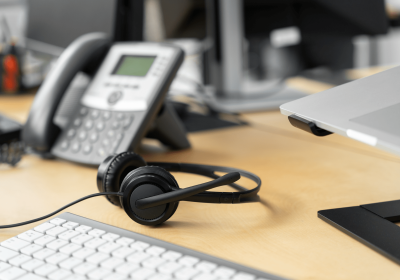In business settings, basic telephone etiquette is more than just courtesy—it’s a key factor in building trust and a strong brand image. How you handle a phone call can shape a client’s perception of your professionalism.
Promptly answering calls, using a friendly and respectful tone, and practicing active listening are essential elements of proper phone manners. Additionally, ensuring clear communication and ending calls politely leaves a lasting positive impression.
Mastering telephone etiquette enhances customer satisfaction, fosters better relationships, and improves overall business communication, making it a valuable skill for every professional in today’s fast-paced work environment.
1. Answer Promptly
Answering phone calls promptly—ideally within the first three rings—demonstrates respect for the caller’s time and signals your attentiveness.
In a business setting, time is a critical factor, and every second a caller waits can affect their perception of your professionalism. Responding quickly not only reduces the caller’s frustration but also creates a sense of urgency, showing that you value their inquiry and are ready to assist.
Prompt responses also help establish a professional image for your organization. Whether you’re interacting with a client, a partner, or a colleague, answering calls without delay reflects reliability and competence.
It gives the impression that your company operates efficiently, with well-organized processes and proactive team members who are prepared to handle inquiries.
On the other hand, delays in answering calls can cause unnecessary frustration for the caller. Prolonged waiting times often lead to negative experiences and may harm your company’s reputation.
If answering immediately isn’t possible, ensure that an automated system or voicemail is in place to acknowledge the call and provide clear instructions on how the caller can proceed. Consistently answering calls promptly helps build trust and ensures smoother communication with clients and business partners.
2. Introduce Yourself Immediately
Introducing yourself clearly at the start of a call is a fundamental part of professional telephone etiquette. Begin by stating your name and the department or company you represent. For example, “Good morning, this is [Your Name] from [Department/Company Name]. How may I assist you today?”
This immediate introduction sets the tone for the conversation and establishes trust, as the caller knows they are speaking to the correct person or team.
A proper introduction also helps the caller quickly confirm they’ve reached the right place. Without a clear introduction, callers may feel uncertain or hesitate to proceed with their query, which can lead to frustration.
Providing your name and department eliminates confusion, making it easier for the caller to explain their purpose and for you to address their concerns efficiently.
Additionally, starting with a professional introduction enhances the caller’s overall experience. It conveys respect and professionalism, both of which are crucial in building positive relationships with clients and partners.
A well-structured greeting not only reflects well on you as an individual but also reinforces the organization’s commitment to high standards in communication. This small yet significant step can leave a lasting positive impression on the caller, ensuring they feel valued and respected throughout the interaction.
3. Use A Friendly And Professional Tone
Maintaining a friendly and professional tone during business calls is essential for creating a positive experience. A warm tone makes the caller feel comfortable, welcomed, and valued, which can significantly improve their perception of your organization.
Whether you are handling a routine inquiry or addressing a complex issue, your tone can set the overall mood of the conversation.
A friendly approach reassures callers that they are speaking to someone who genuinely cares about assisting them, while professionalism ensures that the conversation remains focused and respectful.
It’s equally important to avoid sounding bored, distracted, or rushed, as these can leave a negative impression on the caller. Even if you are handling multiple calls throughout the day, maintaining a consistent tone of interest and engagement is critical.
Callers can easily pick up on your attitude through your voice, and sounding uninterested may discourage them from continuing the conversation. Always strive to project enthusiasm and attentiveness, which shows that you take their concerns seriously.
During stressful or difficult conversations, it’s crucial to keep your tone calm and composed. Callers may occasionally express frustration, but responding with a steady, professional tone helps de-escalate the situation.
By staying calm, you demonstrate your ability to manage pressure effectively, which reflects positively on your communication skills. A composed tone reassures the caller that you are capable of resolving their issue efficiently, fostering trust and encouraging a productive dialogue.
4. Speak Clearly And At A Moderate Pace
Speaking clearly is a vital aspect of effective telephone communication. Articulating your words ensures that the caller can understand you without needing to ask for clarification repeatedly. Clarity is especially important when conveying key information, such as instructions, contact details, or next steps.
By pronouncing each word distinctly and avoiding mumbling, you minimize the chances of miscommunication and ensure the conversation flows smoothly.
Maintaining a moderate pace is equally important. Speaking too fast can overwhelm the caller, making it difficult for them to follow the conversation. On the other hand, speaking too slowly may come across as unprofessional or disinterested.
Aim for a balanced pace that allows the caller to grasp your message without feeling rushed. If you tend to speak quickly, practice slowing down slightly, especially when delivering important information or responding to complex questions.
Pausing briefly after important points can enhance the caller’s comprehension. These short pauses give the caller time to process what you’ve said and formulate any follow-up questions they may have.
Additionally, well-timed pauses help prevent you from sounding rushed and ensure that your message is delivered clearly and effectively. By articulating your words, maintaining a moderate pace, and incorporating thoughtful pauses, you can foster clear communication and leave a positive impression on every call.
5. Listen Actively
Active listening is a fundamental component of effective telephone communication. It involves more than just hearing the caller’s words—it requires focusing on their message, understanding their concerns, and responding appropriately.
Showing genuine interest by carefully listening to what the caller has to say fosters trust and helps build a positive relationship. When callers feel that they are being listened to, they are more likely to remain calm and cooperative, even when addressing challenging issues.
Using verbal cues such as “I understand,” “Got it,” or “Thank you for clarifying” can reinforce to the caller that you are actively engaged in the conversation. These phrases signal that you are following along and acknowledging their concerns.
Additionally, such cues help maintain the flow of the conversation, encouraging the caller to share relevant information without feeling ignored or dismissed. Be mindful of your tone when using these phrases to ensure they sound sincere.
Avoid interrupting the caller and allow them to finish speaking before you respond. Interruptions can disrupt the flow of communication and cause the caller to feel that their concerns are not being taken seriously.
Instead, practice patience and take notes if necessary, so you can address all points once they have completed their explanation. Active listening not only ensures that you fully understand the caller’s needs but also enhances the overall quality of the conversation.
6. Avoid Interrupting
Allowing the caller to complete their sentences without interruption is a simple yet critical aspect of telephone etiquette. When you let the caller express their thoughts fully, it shows respect for their time and opinions.
This approach helps you gather complete information before responding, making your answers more accurate and relevant. Listening attentively without interrupting also ensures that the caller feels valued and understood, which can improve their experience and satisfaction.
Interrupting during a call can lead to frustration and make the caller feel unheard or undervalued. Frequent interruptions may cause misunderstandings, as you might miss important details while trying to speak over the caller.
This can result in unnecessary repetition, prolonging the call and diminishing its effectiveness. Even if you believe you already know what the caller is going to say, it’s best to wait until they finish to confirm your understanding.
If you need clarification, wait until the caller has finished speaking before politely asking for more details. For example, you can say, “Could you please elaborate on that point?” or “Just to confirm, did you mean…?”
This respectful approach not only keeps the conversation polite but also ensures that all information is clear and correctly understood. By avoiding interruptions and encouraging open communication, you create a more positive and productive interaction for both parties.
7. Minimize Background Noise
Maintaining clear communication during a call begins with minimizing background noise. Choosing a quiet environment for calls ensures that both parties can hear each other without distractions.
Whether you’re taking a call from the office or working remotely, it’s important to find a space where external sounds are minimal. This helps prevent miscommunication and makes the conversation more productive.
Background noise, such as chatter, traffic, or electronic devices, can significantly reduce call quality and distract both you and the caller. It can also give an unprofessional impression, especially in a business setting.
If background noise cannot be completely eliminated, using a high-quality headset with noise-canceling features can help improve audio clarity. Ensuring a distraction-free environment shows respect for the caller and demonstrates your commitment to maintaining professionalism.
If you find yourself in a noisy environment that cannot be avoided, it’s best to acknowledge the issue and apologize to the caller. A simple statement like, “I apologize for the background noise. I will do my best to assist you,” reassures the caller of your full attention despite the circumstances.
By addressing the situation openly and remaining focused on the conversation, you help maintain a positive experience for the caller, even in less-than-ideal conditions.
8. Use Proper Language
Using clear, professional, and courteous language is essential for maintaining effective communication during business calls. Clear language helps convey your message accurately and ensures that the caller understands what is being discussed.
Being professional means avoiding slang, colloquial expressions, or overly casual phrases, which can diminish your credibility. Courteous language, such as using phrases like “Thank you,” “Please,” and “You’re welcome,” reinforces respect and builds a positive relationship with the caller.
It’s important to avoid jargon unless you are certain that the caller is familiar with industry-specific terms. Using too much technical language can confuse the caller and make the conversation less productive. If you must use certain technical terms, take the time to explain them in simple terms to ensure clarity.
Tailoring your language to match the caller’s level of understanding shows consideration and improves the overall quality of communication.
Staying polite, even when a caller becomes difficult or upset, is crucial in maintaining professionalism. Remaining calm and respectful helps to de-escalate tense situations and keeps the conversation productive. Avoid using negative or dismissive language, and instead, focus on providing helpful solutions.
Phrases like, “I understand your concern” or “Let’s work together to resolve this issue” show empathy and commitment to assisting the caller. By consistently using proper language, you leave a positive impression and strengthen your organization’s reputation for professionalism.
9. Ask Before Placing On Hold
Placing a caller on hold is sometimes necessary, but doing so without proper communication can lead to frustration. Always request the caller’s permission before placing them on hold.
A simple phrase like, “May I place you on hold for a moment while I check that for you?” ensures that the caller feels respected and in control of the situation. This small step demonstrates courtesy and professionalism, making the caller more willing to wait.
It’s important to inform the caller of how long they can expect to wait and to check back periodically if the hold is extended.
Providing an estimated wait time, such as “This will take about one to two minutes,” helps manage expectations and reduces the likelihood of dissatisfaction. If the process takes longer than anticipated, update the caller and offer the option to continue holding or receive a callback.
Once you resume the call, always thank the caller for their patience. A simple statement like, “Thank you for holding. I appreciate your patience,” helps maintain a positive tone and shows that you value their time.
Properly handling the hold process can greatly enhance the caller’s experience and reflects your commitment to high-quality service.
10. Provide Accurate Information
Providing accurate information during a call is critical to ensuring effective communication and preventing misunderstandings. When sharing details, take the time to verify that the information you are providing is correct.
Inaccurate information can confuse the caller and damage your credibility, leading to potential dissatisfaction. Always double-check key details, such as dates, names, or instructions, to ensure they are clear and precise.
If you are unsure about certain information, it is better to be honest with the caller rather than guessing. Politely inform them that you will verify the details and follow up promptly.
For example, you could say, “Let me confirm that information for you, and I will get back to you shortly.” This approach shows that you prioritize accuracy and are dedicated to providing the right answers, even if it means taking extra time.
Providing reliable answers not only resolves the caller’s immediate concern but also builds trust and credibility. Callers are more likely to feel confident in your assistance when they know they are receiving dependable information.
Consistently delivering accurate details enhances the organization’s reputation and fosters stronger relationships with clients and partners.
11. Take Notes During The Call
Taking notes during a call is an essential practice for ensuring that key points are not overlooked. Documenting important information, such as action items, dates, names, and specific details, helps create an accurate record of the conversation.
This ensures that any commitments made during the call are tracked and followed up on, preventing errors or forgotten tasks. Proper notetaking helps both you and the caller stay aligned, making future interactions smoother and more efficient.
Notetaking is particularly useful when you need to escalate the issue or hand it off to another team. Providing clear, well-documented notes ensures that the next person handling the matter has all the relevant information.
This reduces the need for the caller to repeat themselves, enhancing their experience and speeding up resolution time. Thorough notes allow your team to maintain continuity in communication, reflecting a well-organized and professional approach.
Additionally, taking notes during the call signals to the caller that you are serious about addressing their concerns. It shows that you are actively engaged and committed to finding a solution.
Letting the caller know that you are taking notes, with phrases such as “I’m noting that down,” reassures them that their issue is being handled with care and attention.
12. Avoid Multitasking
Avoiding multitasking during a call is crucial for maintaining accuracy and delivering a high level of service. Giving the caller your undivided attention helps prevent misunderstandings and errors that can occur when you are distracted by other tasks.
Even seemingly minor distractions, such as checking emails or working on another document, can result in missing key information or failing to respond appropriately. Staying fully present ensures that you capture every detail of the conversation, leading to better outcomes.
Multitasking during a call can lead to poor communication and a negative experience for the caller. When you divide your attention, it’s easier to lose track of important points or provide incomplete answers. This can frustrate the caller and undermine their trust in your ability to assist them.
Focusing entirely on the conversation helps you respond promptly, provide accurate information, and handle the caller’s concerns more effectively.
By dedicating your full attention to the caller, you convey professionalism and respect for their time. Callers can often sense when they do not have your full focus, which can impact the tone of the conversation.
Ensuring that you are fully engaged demonstrates that you value the caller’s concerns and are committed to resolving their issues in a thorough and efficient manner.
13. Be Mindful Of Your Volume
Maintaining an appropriate volume during phone conversations is critical to ensuring clear communication. Speaking at a moderate volume allows the caller to hear you without straining or feeling overwhelmed.
Proper volume control ensures that your message is delivered effectively, helping to avoid repeated clarifications or misunderstandings. Whether you’re in a quiet office or a noisier environment, finding the right balance is key to keeping the conversation smooth and professional.
Speaking too loudly can come across as aggressive or rude, while speaking too softly may result in the caller struggling to hear you. Both extremes can negatively impact the caller’s experience and lead to frustration.
Always aim for a calm and steady tone that conveys professionalism without overwhelming the listener. If you notice that the caller is frequently asking you to repeat information, it may be a sign that you are speaking too softly.
Adjusting your volume based on the caller’s feedback is an important aspect of effective communication. If the caller mentions difficulty in hearing you, respond by increasing your volume slightly. Conversely, if they indicate that you are speaking too loudly, lower your voice to a comfortable level.
By being mindful of your volume and willing to adapt as needed, you ensure a positive and clear interaction that reflects well on your communication skills.
14. Smile While Talking

Although the caller cannot see you, smiling while speaking can significantly influence how you sound over the phone. Smiling helps your voice sound more positive, approachable, and enthusiastic, creating a welcoming atmosphere for the caller.
A genuine smile can soften your tone and make you appear more engaged and attentive. In business communication, this subtle technique can leave a lasting positive impression on clients, customers, and partners.
Even in situations where the conversation is purely professional, a warm and friendly tone helps set the right mood. Callers are more likely to feel at ease and respond positively when they sense friendliness in your voice.
This can lead to smoother interactions, particularly when discussing complex or sensitive topics. Smiling while talking may feel unnatural at first, but with practice, it becomes a valuable habit for maintaining a pleasant tone.
Smiling can also play a crucial role during difficult conversations. It helps keep your tone calm and composed, which can de-escalate tension and encourage a more cooperative attitude from the caller.
Even if the situation requires delivering less-than-ideal news, maintaining a positive tone by smiling can show empathy and willingness to help. By adopting this simple yet powerful practice, you can improve communication outcomes and foster stronger relationships over the phone.
15. Conclude Calls Politely
Concluding a call politely is just as important as how you begin the conversation. Always take a moment to summarize the key points discussed during the call. This ensures that both you and the caller are aligned on the next steps and helps prevent any misunderstandings.
For example, you might say, “To summarize, we’ve agreed on [specific action or information], and I’ll follow up with [next step].” Providing a clear summary reinforces professionalism and ensures the caller leaves the conversation with a positive impression.
After summarizing, thank the caller for their time. Expressing gratitude shows that you appreciate their effort in reaching out and fosters goodwill. Additionally, offer further assistance by providing contact details for follow-up.
Phrases like, “If you have any more questions, feel free to contact us at [email or phone number],” demonstrate your willingness to assist beyond the initial call. This proactive approach enhances customer satisfaction and leaves the door open for continued communication.
Finally, end the call with a polite closing phrase, such as “Thank you for calling,” or “Have a great day.” These courteous remarks create a friendly and professional atmosphere, ensuring that the conversation ends on a positive note.
A respectful conclusion leaves a lasting impression, making it more likely that the caller will feel satisfied and confident in your service.
16. Check And Respond To Voicemails Promptly
Regularly checking voicemails is a vital part of professional communication. Important messages can arrive when you are unavailable or on another call, and prompt attention to these voicemails ensures that no critical information is missed.
Make it a routine to check voicemails multiple times throughout the day to stay updated on any pending issues. Consistently monitoring your messages helps maintain smooth communication and responsiveness.
Once you’ve checked a voicemail, returning the call promptly shows respect for the caller’s time. Delayed responses can cause frustration and potentially harm your professional relationships.
Whether the message is from a client, a colleague, or a partner, timely follow-up demonstrates your commitment to providing excellent service. Even if you don’t have a complete answer immediately, acknowledging the message and letting the caller know you are working on a solution helps build trust.
When leaving voicemail messages, ensure that your message is brief, clear, and to the point. Begin by stating your name, company, and the purpose of your call. Include any necessary information the recipient might need, and end with a polite request for a callback, if applicable.
For example, “This is [Your Name] from [Company], calling regarding [topic]. Please feel free to reach me at [phone number]. Thank you, and I look forward to hearing from you.”
Keeping voicemails concise yet informative ensures that the recipient understands the purpose of your call without needing to listen multiple times.
17. Avoid Using Speakerphone In Public Areas
Using speakerphone in public areas can compromise both the caller’s privacy and the quality of the conversation. Speakerphones are designed for hands-free communication, but when used in open or noisy environments, they expose sensitive information to unintended listeners.
Protecting the caller’s privacy should always be a top priority in business communication. Avoiding speakerphone in public spaces demonstrates professionalism and respect for the confidentiality of the discussion.
Additionally, background noise in public places can interfere with clear communication. The caller may struggle to hear you, leading to repeated clarifications and a frustrating experience.
Distractions such as chatter, traffic, or environmental sounds can make it difficult for both parties to stay focused. This not only reduces the effectiveness of the conversation but may also result in misunderstandings or errors.
If you must take a call in a public area, inform the caller of the situation and find a quieter place before continuing the conversation.
For example, you could say, “I’m currently in a public area with some background noise. Would you mind if I move to a quieter place to ensure clear communication?” This approach shows consideration for the caller and ensures that important details are communicated accurately.
18. Stay Positive, Even With Difficult Callers
Dealing with difficult callers is a common challenge in business communication, but maintaining a positive attitude is essential for resolving issues effectively. When a caller is upset, it’s important to remain calm and composed, even if they express frustration.
Reacting emotionally can escalate the situation, whereas staying level-headed allows you to manage the conversation professionally. A calm demeanor helps reassure the caller that you are in control and capable of addressing their concerns.
Using empathy to acknowledge the caller’s concerns can significantly improve the outcome of the conversation. Simple phrases like, “I understand how this situation may be frustrating,” or “I appreciate your patience while we resolve this issue,” demonstrate that you care about their experience.
Empathy helps to build rapport and can turn a tense interaction into a more productive dialogue. Once you’ve acknowledged their concerns, focus on offering practical solutions to address the issue.
Keeping a positive attitude throughout the call can help de-escalate tense situations and encourage cooperation. Even if the resolution requires additional steps or time, maintaining an optimistic tone helps set the right expectations.
A positive approach not only improves the caller’s experience but also reinforces your professionalism, leaving a lasting impression of your ability to handle challenging situations with grace and competence.
19. Be Aware Of Time Zones
When making business calls, it’s important to consider the time zone of the recipient to ensure your call is both timely and respectful. Business operations often span across different regions, and being aware of time differences can prevent inconveniencing the person on the other end.
Before placing a call, take a moment to check the recipient’s local time. This small effort shows professionalism and consideration, helping you foster stronger relationships with clients and partners.
Avoid calling too early in the morning or late in the evening, as these are typically personal hours when people may be unavailable or unwilling to take business calls.
A good rule of thumb is to schedule calls during standard business hours in the recipient’s time zone, typically between 9 AM and 5 PM. If the call is urgent and must be made outside these hours, it’s courteous to first send a message or email asking if they’re available to speak.
If you’re unsure about the most convenient time to call, don’t hesitate to ask the recipient. You can say, “When would be a good time for me to call?” or “Please let me know your availability.”
This approach demonstrates respect for their time and allows you to plan the conversation accordingly. By being mindful of time zones, you enhance the overall effectiveness of your communication and leave a positive impression.
20. Regularly Update Your Voicemail Greeting

Maintaining an up-to-date and professional voicemail greeting is essential in ensuring that callers receive the right information when they’re unable to reach you.
An outdated voicemail can lead to confusion or frustration, especially if it provides incorrect details about your availability. Regularly reviewing and updating your voicemail greeting helps ensure that it reflects your current role and availability, enhancing your credibility as a professional.
A professional voicemail greeting should include your name, position, and a brief message indicating when the caller can expect a return call.
For example, “Hello, you’ve reached [Your Name], [Your Position] at [Company]. I’m currently unavailable, but please leave a message, and I will get back to you by [specific time frame].” This gives the caller a clear understanding of what to expect and helps manage their expectations.
If you know that you’ll be unavailable for an extended period, such as during vacations or business trips, it’s a good idea to offer alternative contact methods in your voicemail. You can include the contact information of a colleague who can assist in your absence or suggest emailing you as an alternative.
Keeping your voicemail greeting professional, clear, and up-to-date ensures that callers feel acknowledged, even when you’re not immediately available, and helps maintain seamless communication.
Conclusion About The Telephone Etiquette Conversation
Mastering call etiquette is not just about answering calls correctly—it’s about ensuring clear communication, building trust, and maintaining professionalism during every interaction.
By answering promptly, using a friendly tone, listening actively, and following proper call-handling techniques, you can leave a lasting positive impression on clients and partners. Implementing these practices consistently helps strengthen relationships and fosters a reliable business image.
Telephone etiquette is an ongoing skill that evolves with experience and practice. Whether you’re handling routine inquiries or complex issues, maintaining professionalism over the phone contributes significantly to both personal growth and organisational success.
Ready to take your business communication to the next level? Gear Inc offers tailor-fit BPO solutions, designed to help businesses thrive with dependable services, including live chat support, technical support, email handling, and data entry.
With a dedicated workforce of over 6,000 professionals operating across multiple time zones, Gear Inc ensures seamless support for your business, no matter where you are.
Partner with Gear Inc today, and let’s shift gears towards greater efficiency and growth!
Frequently Asked Questions About The Telephone Etiquette Conversation
What Is The Appropriate Way To Handle Call Transfers?
When transferring a call, always explain to the caller why the transfer is necessary and who they will be speaking with next. Ensure that the person you’re transferring the call to is available and prepared to handle the issue.
Additionally, offer to stay on the line until the caller is successfully connected, which helps ensure a smooth handover and prevents unnecessary frustration.
How Long Should I Keep Someone On Hold During A Call?
It’s best to keep hold times as short as possible, ideally no longer than 1-2 minutes. If a longer hold is required, check back with the caller periodically to update them on the progress. Always thank the caller for their patience when resuming the conversation, as this helps maintain a positive experience.
Does Call Etiquette Vary Across Different Industries?
Yes, call etiquette can vary depending on the industry and the nature of the conversation. For example, customer support in retail may require a friendly and empathetic tone, while calls in healthcare or legal services demand a higher level of formality and confidentiality.
Understanding industry-specific expectations ensures that your communication style aligns with the caller’s needs.
Can I Use Informal Language During A Business Call?
Using informal language during a business call depends on the context and relationship with the caller. For internal calls or conversations with familiar colleagues, informal language may be acceptable.
However, when speaking with clients, customers, or external partners, it’s best to use professional language to maintain respect and credibility.



















